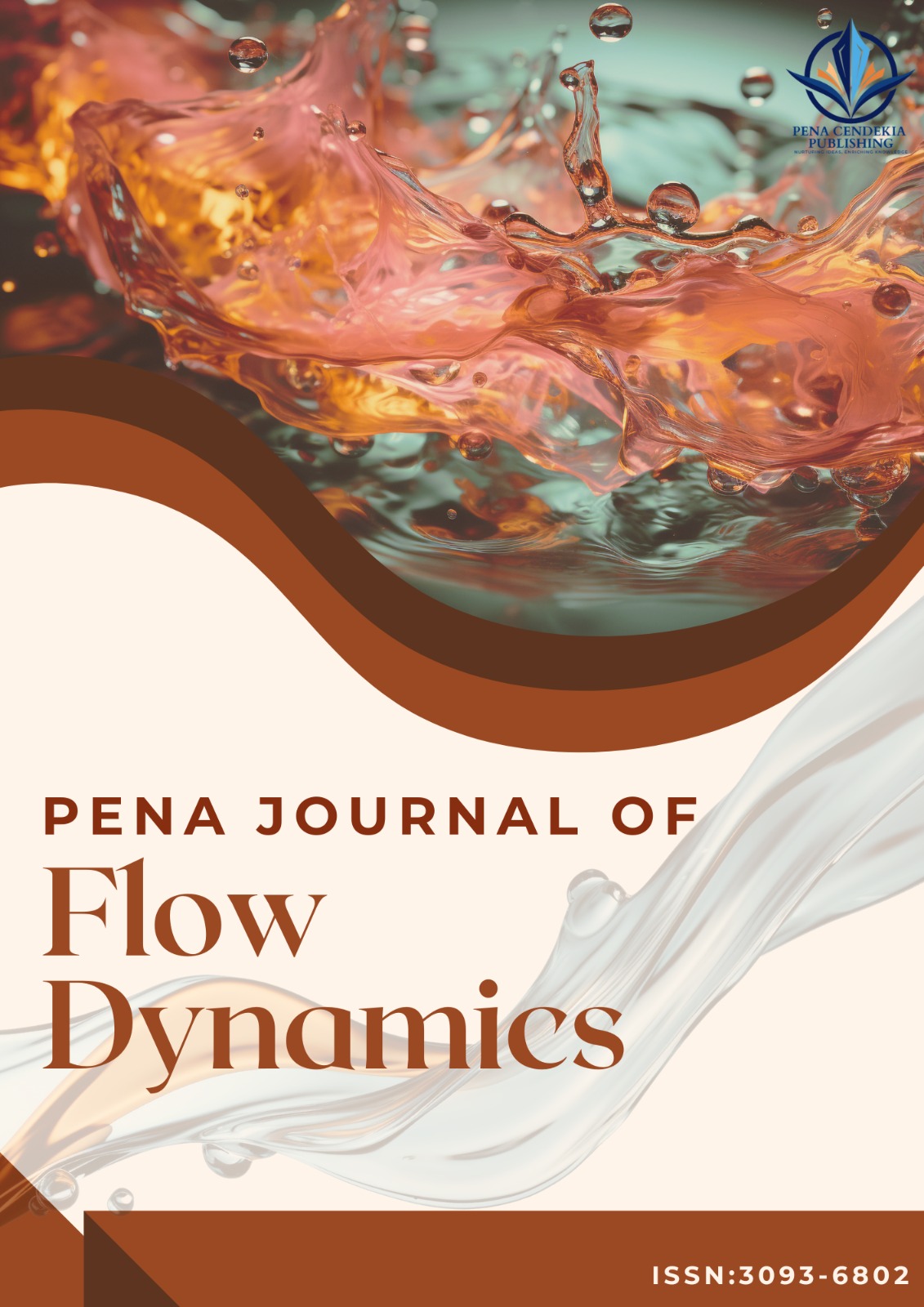Investigation on Blade Angles Effect on Micro-Gravitational Water Vortex System via Simulation and Experimental Analysis
DOI:
https://doi.org/10.37934/pjfd.1.1.1327Keywords:
Simulation, Computational Fluid Dynamics, micro gravitational water vortex, Kaplan turbine, blade angle, green energyAbstract
Micro gravitational water vortex power plants offer a promising solution for generating electricity from renewable energy sources with minimal hydraulic pressure requirements. Increased energy generation results from an increased vortex formation. Thus, the design of a micro gravitational water vortex system aims to achieve a powerful artificial air-core vortex. This study focused on investigating the effect of different blade angles in a Kaplan turbine within a micro gravitational water vortex system. Computational fluid dynamics (CFD) simulations conducted using Ansys software provided detailed insights into fluid flow dynamics, while experimental validation of the numerical results involved computational design and modelling, fabrication of the blades prototype on a 3D printer, and experimental data collection. Three blade angles at 140°, 150°, and 160°, were examined to determine its effects on power efficiency, approximate power input, and output. Simulation results indicate that a blade angle of 140° yields the highest power efficiency, reaching an impressive value of 95.40%. This efficiency outperforms the other blade profiles investigated. Experimental results showed reasonable consistency with the numerical predictions, with errors between numerical and experimental value ranging from 4.5% to 27.6%. Findings presented in this paper emphasised the importance of blade angle selection in optimizing the performance of micro gravitational water vortex power plants. Valuable insights for the design and operation of this eco-friendly technology aid the advancement of green energy generation systems.
References
[1] Brijkishore, Ruchi Khare, and Vishnu Prasad. "Performance evaluation of Kaplan turbine with different runner solidity using CFD." In Advanced Engineering Optimization Through Intelligent Techniques: Select Proceedings of AEOTIT 2018, pp. 757-767. Singapore: Springer Singapore, 2019. https://doi.org/10.1007/978-981-13-8196-6_67 DOI: https://doi.org/10.1007/978-981-13-8196-6_67
[2] Chan, Zin Mar, and Zar Ni Aung. "Design calculation of Kaplan Turbine Runner Blade for 15kw Micro Hydropower Plant." International Journal for Advance Research and Development 5, no. 4 (2020): 14-16.
[3] Dhakal, Sagar, Ashesh B. Timilsina, Rabin Dhakal, Dinesh Fuyal, Tri R. Bajracharya, Hari P. Pandit, Nagendra Amatya, and Amrit M. Nakarmi. "Comparison of cylindrical and conical basins with optimum position of runner: Gravitational water vortex power plant." Renewable and Sustainable Energy Reviews 48 (2015): 662-669. https://doi.org/10.1016/j.rser.2015.04.030 DOI: https://doi.org/10.1016/j.rser.2015.04.030
[4] Kueh, Tze Cheng, Shiao Lin Beh, Dirk Rilling, and Yongson Ooi. "Numerical analysis of water vortex formation for the water vortex power plant." International Journal of Innovation, Management and Technology 5, no. 2 (2014): 111.
[5] Maika, Nosare, Wenxian Lin, and Mehdi Khatamifar. "A review of gravitational water vortex hydro turbine systems for hydropower generation." Energies 16, no. 14 (2023): 5394. https://doi.org/10.3390/en16145394 DOI: https://doi.org/10.3390/en16145394
[6] Jorge Morales Pedraza. 2022. Chapter 2 - The use of hydropower for electricity generation. In Non-Conventional Energy in North America, Jorge Morales Pedraza (ed.). Elsevier, 89-135. https://doi.org/10.1016/B978-0-12-823440-2.00010-X DOI: https://doi.org/10.1016/B978-0-12-823440-2.00010-X
[7] Nishi, Yasuyuki, Ryouta Suzuo, Daichi Sukemori, and Terumi Inagaki. "Loss analysis of gravitation vortex type water turbine and influence of flow rate on the turbine’s performance." Renewable Energy 155 (2020): 1103-1117. https://doi.org/10.1016/j.renene.2020.03.186 DOI: https://doi.org/10.1016/j.renene.2020.03.186
[8] Power, Christine, Aonghus McNabola, and Paul Coughlan. "A parametric experimental investigation of the operating conditions of gravitational vortex hydropower (GVHP)." Journal of Clean Energy Technologies 4, no. 2 (2016): 112-119. https://doi.org/10.7763/JOCET.2016.V4.263 DOI: https://doi.org/10.7763/JOCET.2016.V4.263
[9] Rahman, M. M., J. H. Tan, M. T. Fadzlita, and AR Wan Khairul Muzammil. "A review on the development of gravitational water vortex power plant as alternative renewable energy resources." In IOP Conference Series: Materials Science and Engineering, vol. 217, no. 1, p. 012007. IOP Publishing, 2017. https://doi.org/10.1088/1757-899X/217/1/012007 DOI: https://doi.org/10.1088/1757-899X/217/1/012007
[10] Alejandro Ruiz Sánchez, Jorge Andrés Sierra Del Rio, Angie Judith Guevara Muñoz, and José Alejandro Posada Montoya. "Numerical and Experimental Evaluation of Concave and Convex Designs for Gravitational Water Vortex Turbine." J. Adv. Res. Fluid Mech. Therm. Sc. 64, no. 1 (2020): 160-172.
[11] Shabara, H. M., O. B. Yaakob, Yasser M. Ahmed, and A. H. Elbatran. "CFD simulation of water gravitation vortex pool flow for mini hydropower plants." Jurnal Teknologi (Sciences & Engineering) 74, no. 5 (2015). https://doi.org/10.11113/jt.v74.4645 DOI: https://doi.org/10.11113/jt.v74.4645
[12] Sharif, A., M. Siddiqi, and R. Muhammad. "Novel runner configuration of a gravitational water vortex power plant for micro hydropower generation." Journal of Engineering and Applied Sciences 39, no. 1 (2020): 87-93. https://doi.org/10.17582/journal.jeas/39.1.87.93 DOI: https://doi.org/10.17582/journal.jeas/39.1.87.93
[13] Sritram, P., and R. Suntivarakorn. "The effects of blade number and turbine baffle plates on the efficiency of free-vortex water turbines." In IOP Conference Series: Earth and Environmental Science, vol. 257, no. 1, p. 012040. IOP Publishing, 2019. https://doi.org/10.1088/1755-1315/257/1/012040 DOI: https://doi.org/10.1088/1755-1315/257/1/012040
[14] Sritram, Piyawat, and Ratchaphon Suntivarakorn. "Comparative study of small hydropower turbine efficiency at low head water." Energy Procedia 138 (2017): 646-650. https://doi.org/10.1016/j.egypro.2017.10.181 DOI: https://doi.org/10.1016/j.egypro.2017.10.181
[15] Tamiri, F. M., M. A. Ismail, and W. K. Muzammil. "Low head micro hydro systems for rural electrification." In IOP Conference Series: Materials Science and Engineering, vol. 834, no. 1, p. 012041. IOP Publishing, 2020. https://doi.org/10.1088/1757-899X/834/1/012041 DOI: https://doi.org/10.1088/1757-899X/834/1/012041
[16] Wanchat, Sujate, and Ratchaphon Suntivarakorn. "Preliminary design of a vortex pool for electrical generation." Advanced Science Letters 13, no. 1 (2012): 173-177. https://doi.org/10.1166/asl.2012.3855 DOI: https://doi.org/10.1166/asl.2012.3855














